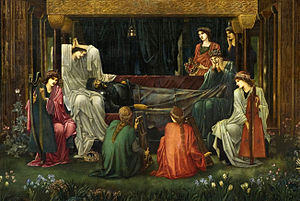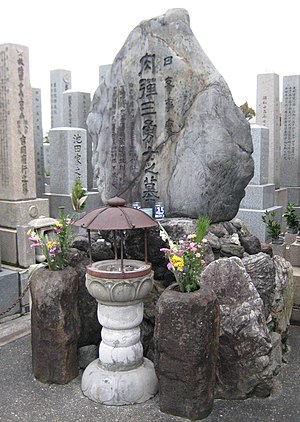 Image via WikipediaLe Mort d'Arthur
Image via WikipediaLe Mort d'Arthur is an extremely famous work of literary collection preserved by
Sir Thomas Malory, or 'Malleorre,' as he may have called himself. The collection of stories is quite impressive. Originally, it spanned a series of eleven volumes. It remains as one of the most favourite cornerstones of English legend, lore, and fantasy. Most people, and even children, know something of King Arthur,
Sir Lancelot, and Guenevere. These books have long been on my wish list. What's more, it's something that, if ever I find succour in my own books, that I would love to rewrite for a massive series of Arthurian graphic novels whose narratives would be true to Malory's versions. They are available freely available at
Gutenberg.org.
I always find it remarkable, and more than perhaps lamentable, how refined most tales become over the centuries. Modern Arthurian tales often suggest relatively perfect heroes. However, the original tales, considered under the microscope of modern heroic ethos.
Nothing brings to home my point of how characters of long ago were not the characters of today like Book I.
Book I explains the origin of Arthur.
Uther Pendragon was his father. Pendragon had hosted a good couple, Duke of Tintgail and his wife Igraine, to his castle when he fell in love or lust with Igraine. As a result, as they stay in his home, he tries to lay with her. She repulses his advances, and the couple flee from Pendragon. This, however, is not sufficient for him, and he follows in hot pursuit with his knights and his mean wizard,
Merlin.
Immediately following the death of the duke, Pendragon took on the likeness of the duke and quickly satiates his lust on Igraine. Thus was Arthur begat. By the following morning, she discovers the deception and weds another named Ulfius.
Morgan Le Fay would be their daughter and Arthur's sister, sent to a nunnery where she learnt necromancy. What a bizarre place to learn necromancy, I find. Pendragon also sent Arthur away from his castle to be raised by foster parents.
One of the most famous scenes from the legend of Arthur is in this book. Here, as a young man or a nearly grown man, he manages to withdraw the legendary sword from a stone: more than once to prove to other contenders that he was the rightful king of them all.
There are many kings who fight to resist Arthur's claim to the throne. Many of them rise up to fight against him. Through a combination of strength, cunning, guile through wizardry, Arthur and his knights manage to defeat all his opponents.
Also noteworthy is the finding of Excalibur which will give Arthur some magical powers. First, a matchless sword, and second the scabbard which will save him from bleeding for as long as he holds onto it. So, though an excellent warrior, a part of his excellence is through magical power. However, in a later chapter, his biological mother is accused by her husband, of bringing the calamity of war to the land. Arthur does not know at this point that Igraine is his mother. Soon it comes out that Igraine is Arthur's mother, and that the sin which had caused so much vexation was that Arthur had had sex with his sister. However, it does not reveal which. The anger which Morgan Le Fay had for Arthur makes me suspect that it was her that she had lain with, and an analysis at
Timeless Myth seems to confirm my suspicion. The child of this union was
Mordred.
Merlin warns Arthur that Mordred would result in the end of Arthur. The closing chapter describes how many young children, "some four weeks old," were put onto a ship that was then put to sea. Many of those who had lost their children blamed Merlin. The boat was dashed near a castle, and all the children lost save Mordred, who was reared by a good man 'Till he was fourteen.'
These characters of Arthur, Pendragon, and Merlin are deceptive and do things which would be unforgivable in our era. Of course, laying with his half-sister, might be forgiven for not knowing. However, the pointless sacrifice of the children to save himself is something difficult to forgive.
Of course, it reminds me somewhat of the ancient Greek legend of Oedipus where his father had cast him aside due to the fate he'd heard of his son killing him and marrying his mother. As a result, he sent Oedipus away hoping to stop fate from fulfilling her story. However, all could not be stopped any more than Arthur will prevent his own death at the hands of his ill begotten son.
Sir Balin
A sword comes in by lady which may only be drawn from its scabbard by the best knight. That best knight so happens to be Sir Balin, who is cursed to be the one who achieves the drawing. He is reviled and chased out of the court.
Away from court, he vows to do such great deeds that Arthur may no longer revile him, and earn his love. He does so by slaying, alongside his brother Balan, nearly all of Arthur's immediate enemies. Without the two brothers, it may have been that Arthur never would have left England.
Finally, the two brothers find their demise at each other's hands. They do not recognize each other when they come together to fight until they have been so sorely wounded that no aid may save them. So they die and are well entombed by Merlin.
![Pyle, Howard,]() Image via Wikipedia
Image via Wikipedia
Though the first part is about Arthur and his getting Guenever, Book II is primarily about the adventure of Sir Gawaine. His a particular favourite of mine, thanks of course to the story,
Sir Gawaine and the Green Knight which is one of best early English stories I've read.
Gawaine is sent on a quest to capture a hart, or deer, that happened to enter the court of King Arthur.
These books are all very violent. Everything from beheading of undesirable ladies to a seemingly endless series of battles, it is choke full of adventure. The purpose of violence can be many: revenge for another killing, regardless of whether or not the deceased being avenged was the cause or not; and even in one instance to settle the argument of who is the fairest queen.
Sir Tristram
Sir Tristram is one of the interesting knights. He is the one, it is said, who is closest to Sir Lancelot in prowess. However, it is unknown who would be the greater knight, since they almost never come to clash one against the other while they are both fresh. Sir Tristram is often conflicted with his duty and his own best interest. In every instance, where duty calls, regardless of the consequence to himself, he always does what duty requires of him.
 Image via Wikipedia
Image via WikipediaThe most destructive relationship he has throughout is with King Mark, his uncle. His uncle, for instance, knowing how much Tristram is in love with Isoude. For this reason, King Mark demands that Tristram fetch her to serve him as his own wife. Tristram does as he is told.
Volume I leaves without having completed the story of Tristram. So, I will have to conclude my thoughts of Sir Tristram in my review of Volume II.















